Newly identified agent, YK-4-279, when used in combination with Vincristine, an FDA approved drug to treat Ewing’s Sarcoma, halts cancer growth and progression.

‘Vincristine and YK-4-279 novel compound both lower the cancer cell's ability to survive, but together their effectiveness magnifies compared to if they were used alone.’





The study, published October 3 in the journal Science Signaling (Inhibition of the oncogenic fusion protein EWS-FLI1 causes G2-M cell cycle arrest and enhanced vincristine sensitivity in Ewing's sarcoma), tests a combination of YK-4-279, the compound developed at Georgetown, with vincristine in laboratory and mice studies. Vincristine is one of the chemotherapy drugs now used to treat Ewing sarcoma. "Each of the two drugs impacts the cancer cell's ability to survive, but they do it in a way that magnifies their effectiveness compared to if they were used alone. It's like a left hook followed by an uppercut," says the study's senior investigator, Jeffrey Toretsky, MD, a pediatric oncologist and researcher at Georgetown Lombardi.
Ewing’s Sarcoma
In the United States, about 500 children and young adults are diagnosed with Ewing sarcoma annually. Between 60 to 70 percent of patients survive more than five years, but with many late effects from treatment. Patients with Ewing sarcoma are currently treated with a combination of five different chemotherapy drugs, which often damages nerves and few treatments lead to a cure when the cancer progresses, Toretsky says.
Ewing sarcoma is caused by the exchange of DNA between two chromosomes. The resulting EWSR1-FLI1 gene produces a fusion protein, EWS-FLI1, responsible for cancer's growth. In 2006, Toretsky and his team discovered that the fusion protein binds to another protein, RNA helicase A (RHA), which is important for cancer progression.
Advertisement
Overview of the study
Advertisement
Microtubules are tube-like structures that help cells keep their shape and act like highways that transport cellular proteins. They also pull apart chromosomes when they divide, and it is this action that is particularly affected by the drug combo, Toretsky says.
"Cancer needs to grow, and to do that, the cells need to divide and multiply. This is the step both drugs target, but in different ways," he says.
According to Toretsky, Oncternal is planning to test the combination of TK216 and vincristine in patients.
Source-Eurekalert












